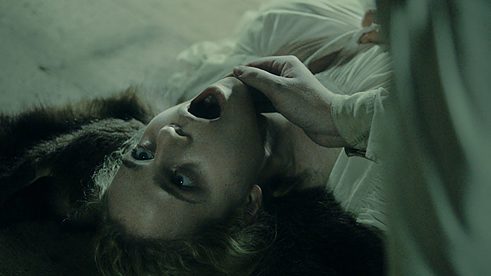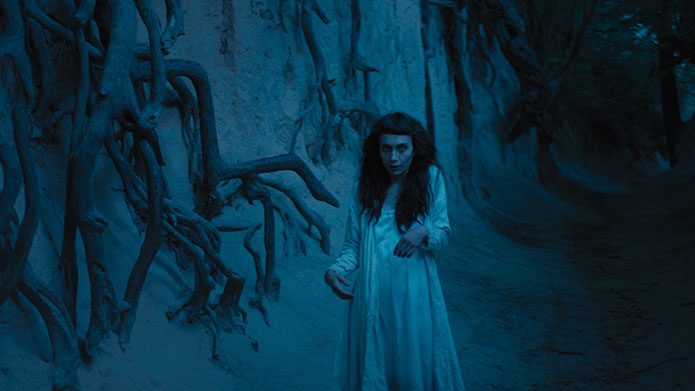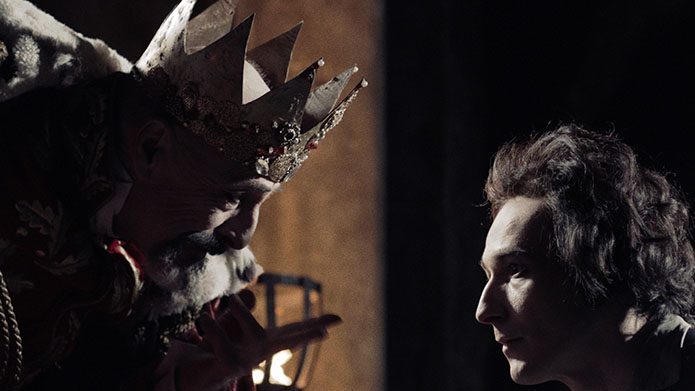MIFF 2018
The Field Guide to Evil: Myths, mysteries and menace

In ‘The Kindler and the Virgin’, one of ‘The Field Guide to Evil’s eight portentous yet perceptive short films, a man is promised wisdom and glory. A white-clad woman accosts him in a snowy pass, and whispers words he didn’t know he wanted to hear: if he consumes three hearts of the freshly deceased, he’ll gain untold knowledge and power.
He follows suit, as many would. The prophecy is fulfilled; however when reckoning eventually comes with it, he spins a twisted, alluring promise in turn. As such, a cycle is established, one that sits at the core of this anthology effort. In her brief, suitably ominous and fittingly astute contribution, Polish filmmaker Agnieszka Smoczynska’s (The Lure) ‘The Kindler and the Virgin’ encapsulates the essence of The Field Guide to Evil. Here, fear and desire are two sides of the same coin, as they’ll continue to be for the entirety of human existence.
Dream-like truths
Across its assemblage of shorts, The Field Guide to Evil explores this idea with moody relish. The latest anthology from The ABCs of Death producers Ant Timpson and Tim League, it’s a movie that makes ample use of its mélange of parts, utilising different shorts from different filmmakers — in different languages, places, time periods and styles, too — to embody the all-encompassing nature of its central subject matter. Stepping into the darkness, sashaying through deep-seeded needs and anxieties, and scrutinising the stories spun about each, it delves into twisted folklore tales that speak to humanity’s urges and woes. More than that, the film favours narratives that warn not just about figures and things that go bump in the night, but about the feelings that such worries relate to. Polish filmmaker Agnieszka Smoczynska’s ('The Lure') ‘The Kindler and the Virgin’ encapsulates the essence of 'The Field Guide to Evil'.
| © The Field Guide to Evil
It should come as no surprise, then, that The Field Guide to Evil uses its opening rhyme to offer its own overarching promise — to tell more than it shows, and to let audiences glean more than they see and hear. Presented as a collection of dream-like chapters, complete with an on-screen representation of a book turning, chapter titles and written introductions, its contents mightn’t represent reality, but they always speak to real truths.
Polish filmmaker Agnieszka Smoczynska’s ('The Lure') ‘The Kindler and the Virgin’ encapsulates the essence of 'The Field Guide to Evil'.
| © The Field Guide to Evil
It should come as no surprise, then, that The Field Guide to Evil uses its opening rhyme to offer its own overarching promise — to tell more than it shows, and to let audiences glean more than they see and hear. Presented as a collection of dream-like chapters, complete with an on-screen representation of a book turning, chapter titles and written introductions, its contents mightn’t represent reality, but they always speak to real truths.
Darkness in Deutsch
In the two German-language inclusions in the movie, three filmmakers find different ways to examine an all-too-familiar topic: the many threads that spring from feminine sexuality. It’s a subject that’s far from unique in recent horror efforts from the area, with Lukas Feigelfeld’s Hagazussa: A Heathen’s Curse also wading through the same terrain. Still, familiarity doesn’t breed contempt in The Field Guide to Evil’s two segments, which find smart and stylish ways to approach their narratives. Women following their desires are once again seen as a threat — and, once again, this pair of shorts isn’t willing to accept society’s pervasive attitude.Austria’s ‘The Sinful Women of Hollfall’ commences The Field Guide to Evil, doing so with agenda-setting aplomb. Goodnight Mommy directors Severin Fiala and Veronika Franz tell of ‘die trud’, a monster born from guilt and fear — and a manifestation of one young woman’s love for another. As the film revels in its rustic period setting and the wooden greenery that it necessitates, Fiala and Franz’s protagonist is forced to discern the forest from the trees as she weighs up her yearnings and their repercussions. Crucially, she doesn’t swap her sense of self for allegiance to superstition, as sinful as her actions are perceived by the rest of her all-female community.
Coming later, but by no means a lesser effort, German director Katrin Gebbe also charts the impact of a menacing force that troubles from the outside but burrows deep within. And ’A Nocturnal Breath’ also offers a literal interpretation, with Bavarian malevolent spirits known as a ‘drudes’ leaving the bodies of the possessed to spread their ill will elsewhere. As she did in Nothing Bad Can Happen, Gebbe doesn’t miss an opportunity to dive into a climate of unease, or to subvert expectations in the process, this time focusing on an inflicted teen cared for by her brother. While any of The Field Guide to Evil’s eight installments can be said to encapsulate its overall thrust — as chapters in an anthology are designed to do, of course — Gebbe’s short lets humanity’s perceived and actual misdeeds first fester, then scurry and spread.
Deep-seeded unease around the world
Elsewhere, in flitting from Turkey, India and America to Greece and Hungary, The Field Guide to Evil rifles through tales that couldn’t be more varied, narrative-wise, and yet also couldn’t have more in common thematically. When Turkish inclusion ‘Haunted by the Al Karisi, the Childbirth Djinn’ tells of the demon that visits a vain young woman after giving birth, Can Evrenol (Baskin) offers yet another a manifestation of inner concerns brought to life. So do does the segment that follows a few chapters later, with Ashim Ahluwala’s (Daddy) ‘The Palace of Horrors’ unfurling the insidious side of searching for a spectacle — and of the western world indulging its colonial impulses — as a circus scout seeks unusual curiosities on a trip to India. Peter Strickland’s ('The Duke of Burgundy') ‘Cobbler’s Lot’ twists the folktale ‘The Princesses’ Curse’.
| © The Field Guide to Evil
In the American and Greek additions to the fold, Calvin Reeder’s (The Rambler) ‘The Melon Heads’ and Yannis Veslemes’s (Norway) ‘What Ever Happened to Panagas the Pagan?’, the same tune is played — one dealing with parental neglect, the other with drunken access. And, finally, Peter Strickland’s (The Duke of Burgundy) ‘Cobbler’s Lot’ twists the folktale ‘The Princesses’ Curse’ into a silent, pantomime-style rumination on jealousy. Each feeds into a wide-ranging examination of myths, mysteries and menace, one that ultimately melds together like a spirited patchwork. The result bewitches, through mood, theme and style sometimes more than story, though the fact that some shorts stand out more than others is emblematic of the format above all else.
Peter Strickland’s ('The Duke of Burgundy') ‘Cobbler’s Lot’ twists the folktale ‘The Princesses’ Curse’.
| © The Field Guide to Evil
In the American and Greek additions to the fold, Calvin Reeder’s (The Rambler) ‘The Melon Heads’ and Yannis Veslemes’s (Norway) ‘What Ever Happened to Panagas the Pagan?’, the same tune is played — one dealing with parental neglect, the other with drunken access. And, finally, Peter Strickland’s (The Duke of Burgundy) ‘Cobbler’s Lot’ twists the folktale ‘The Princesses’ Curse’ into a silent, pantomime-style rumination on jealousy. Each feeds into a wide-ranging examination of myths, mysteries and menace, one that ultimately melds together like a spirited patchwork. The result bewitches, through mood, theme and style sometimes more than story, though the fact that some shorts stand out more than others is emblematic of the format above all else.